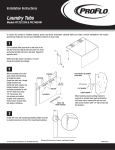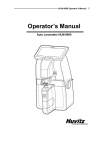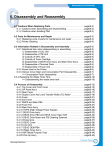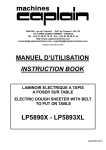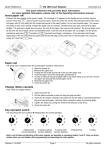Download INSTALLATION & OPERATION MANUAL
Transcript
INSTALLATION &OPERATION MANUAL 6000 SERIES LIGHT BARSTM TM LOW PROFILE LIGHT BAR Contents: IMPORTANT: Introduction ............................................................. 2 Unpacking&Pre-Installation ....................................... 2 Installation&Mounting ............................................... 3 SirenSpeakers ......................................................... 3 Hook-onMounting .................................................. 4 PermanentMounting ............................................... 5 Wiring Instructions .................................................. 6 Maintenance ............................................................ 7 PartsList(ReplacementParts/ExplodedView) ................ 8 Options ................................................................. 11 Specifications ......................................................... 11 Warranty ............................................................... 12 Readallinstructionsandwarningsbeforeinstallingandusing. INSTALLER: Thismanualmustbedeliveredtotheenduserofthisequipment. Introduction All LP 6000 Series light bars include mounting kits, packed in a separate small box inside the box containing the light bar. The standard kit may be used for hook-on or permanent mounting. Towing & Recovery bars, normally pylon mounted, do not include mounting kits, however. These are optionally available from your dealer or the factory. ! WARNING! The use of this or any warning device does not ensure that all drivers can or will observe or react to an emergency warning signal. Never take the right-of-way for granted. It is your responsibility to be sure you can proceed safely before entering an intersection, driving against traffic, responding at a high rate of speed, or walking on or around traffic lanes. The effectiveness of this warning device is highly dependent upon correct mounting and wiring. Read and follow the manufacturer’s instructions before installing or using this device. The vehicle operator should ensure daily that all features of the device operate correctly. In use, the vehicle operator should ensure the projection of the warning signal is not blocked by vehicle components (i.e.: open trunks or compartment doors), people, vehicles, or other obstructions. This equipment is intended for use by authorized personnel only. It is the user’s responsibility to understand and obey all laws regarding emergency warning devices. The user should check all applicable city, state and federal laws and regulations. Public Safety Equipment, Inc., assumes no liability for any loss resulting from the use of this warning device. Proper installation is vital to the performance of this warning device and the safe operation of the emergency vehicle. It is important to recognize that the operator of the emergency vehicle is under psychological and physiological stress caused by the emergency situation. The warning device should be installed in such a manner as to: A) Not reduce the output performance of the system, B) Place the controls within convenient reach of the operator so that he can operate the system without losing eye contact with the roadway. Emergency warning devices often require high electrical voltages and/or currents. Properly protect and use caution around live electrical connections. Grounding or shorting of electrical connections can cause high current arcing, which can cause personal injury and/or severe vehicle damage, including fire. Do not touch the strobe light tubes, the strobe light head assemblies or the strobe power supply while the system is in operation. Wait 10 minutes after turning off the power from system before touching any internal components. PROPER INSTALLATION COMBINED WITH OPERATOR TRAINING IN THE PROPER USE OF EMERGENCY WARNING DEVICES IS ESSENTIAL TO ENSURE THE SAFETY OF EMERGENCY PERSONNEL AND THE PUBLIC. Unpacking & Pre-installation Carefully remove the light bar from the shipping carton and place on a flat surface, taking care not to damage the wire cable coming out of the bottom. Examine the unit for transit damage, cracked lenses, dented speaker cover, etc. If convenient, you may wish to bench test the unit before installing. Before applying voltage to the bar, be sure you have read and understand the wiring instructions attached to the cable. Standard LP6000TM bars operate on 12 volt D.C. negative ground (earth) systems only. If you have a positive ground (earth) vehicle, or any other type of system, and have not ordered a specially wired bar, contact the factory for instructions. 2 Installation & Mounting Siren Speakers NOTE! Use only speaker horns shaped specifically for the LP Light Bar (Z100, LP58 Speaker assemblies or LPKIT Speaker Conversion Kit for use with a user supplied driver). Use of any other speaker horns will obstruct the proper attachment of the speaker cover and void the warranty. It is generally easier to install siren speakers before mounting the bar on the vehicle. No. 8 sheet metal screws will easily break through the metallic tape and thread into the punched holes in the frame. (647S (All 47" Light Bars with speaker center section)) Remove the stainless steel speaker cover by unscrewing the two screws at each end and lifting off. Using the mounting holes indicated, mount either an LP58 or an Z100 speaker. See Illustration 1 for hole locations. Connect the speaker wires to the prewired terminal block and replace the speaker cover. 655A (All 55" Light Bars) Remove the stainless steel speaker cover by unscrewing the two screws at each end and lifting off. Using the mounting holes indicated, mount either one or two LP58 or Z100 speakers. See Illustration 2 for hole locations. Connect the speaker wires to the prewired terminal block and replace the speaker cover. When using two siren speakers, follow speaker manufacturer’s instructions for correct phasing of speakers. NOTE! On all bars with speaker sections, after mounting speaker(s), check to make sure that the cover clears the speaker in the front and rear. If not, loosen the mounting screws and reposition the speaker as necessary. Improper mounting will bind the speaker cover and prevent the lenses from sealing correctly. Sirens are an integral part of an effective audio/visual emergency warning system. However, sirens are only short range secondary warning devices. The use of a siren does not ensure that all drivers can or will observe or react to an emergency warning signal, particularly at long distances or when either vehicle is traveling at a high rate of speed. Sirens should only be used in a combination with effective warning lights and never relied upon as a sole warning signal. Never take the right of way for granted. It is WARNING! your responsibility to be sure you can proceed safely before entering an intersection, SIRENPRODUCTS: driving against traffic, or responding at a high rate of speed. The effectiveness of this warning device is highly dependent upon correct mounting and wiring. Read and follow the manufacturer’s instructions before installing or using this device. The vehicle operator should check the equipment daily to ensure that all features of the device operate correctly. To be effective, sirens must produce high sound levels that potentially can inflict hearing damage. Installers should be warned to wear hearing protection, clear bystanders from the area, and not to operate the siren indoors during testing. Vehicle operators and occupants should access their exposure to siren noise and determine what steps, such as consultation with professionals or use of hearing protection, should be implemented to protect their hearing. This equipment is intended for use by authorized personnel only. It is the user’s responsibility to understand and obey all laws regarding emergency warning devices. The user should check all applicable city, state, and federal laws and regulations. Public Safety Equipment, Inc., assumes no liability for any loss resulting from the use of this warning device. ! 3 Proper installation is vital to the performance of the siren and the safe operation of the emergency vehicle. It is important to recognize that the operator of the emergency vehicle is under psychological and physiological stress caused by the emergency situation. The siren system should be installed in such a manner as to: A) Not reduce the acoustical performance of the system, B) Limit as much as practical the noise level in the WARNING! passenger compartment of the vehicle, C) Place the controls within convenient reach of SIRENPRODUCTS: the operator so that he/she can operate the system without losing eye contact with the roadway. Emergency warning devices often require high electrical voltages and/or currents. Properly protect and use caution around live electrical connections. Grounding or shorting of electrical connections can cause high current arcing, which can cause personal injury and/or severe vehicle damage, including fire. PROPER INSTALLATION COMBINED WITH OPERATOR TRAINING IN THE PROPER USE OF EMERGENCY WARNING DEVICES IS ESSENTIAL TO ENSURE THE SAFETY OF EMERGENCY PERSONNEL AND THE PUBLIC. ! Hook-on Mounting Begin the installation by attaching the rubber feet to the mounting brackets using the 1/4" bolts and acorn nuts provided. (See Illustration 3;) do not install shims at this time. Using a pad to protect the roof of the vehicle, place the light bar on the roof and determine the correct location of the bar and the best pair of holes for attaching the mounting tabs. Attach the washers provided and one of the three pairs of 1/4" mounting holes supplied on each end of the bar. (See Illustration 3 for alternate hole locations.) Place the bar on the vehicle roof and attempt to locate a position in which the bar is level fore and aft. If leveling is required, install the shim washers at this time. (See Illustration 3.) If additional leveling is still needed, contact the factory for assistance. Lift each end of the light bar and insert the 5/16-18 x 2-1/2" hex bolt from the back side. (See Illustration 3.) Install the gutter hooks, lock washers, trim nuts, and tighten until secure. DO NOT OVERTIGHTEN: It is not necessary to dimple the roof in order to achieve a secure and stable mount. 4 NOTE! The mounting brackets are slotted to allow continuous adjustment from hole to hole. When the brackets are installed, the rubber feet should rest as close to the edge of the roof as possible; (See Illustration 4.) Generally, with a 47" light bar, the outboard set of holes would be used for all full size and many intermediate size vehicles. The tabs holding the rubber feet may be bent to conform to the roof profile as shown in Illustrations 4 and 6. Some vehicles may require a slightly longer or shorter mounting bolt. These are 5/16" coarse thread bolts which can be obtained locally. Permanent Mounting Examine the roof of the vehicle to determine the areas of greatest roof strength as well as location of air horns, etc. that will affect the location of the light bar. Select the holes that will place the mounting feet in the location selected and attach the feet to the underside of the light bar, using the 5/16-18 thread forming bolts and 5/16" flat washers provided. (See Illustration 5 for alternate hole location.) Attempt to locate a position in which the bar is level fore and aft. If leveling is required, slide the shim washer under the appropriate tabs on the mounting brackets. (See Illustration 5.) If additional leveling is still needed, contact the factory for assistance. Once the bar is level front to rear and centered side to side, mark the holes through the mounting tabs and remove the bar from the vehicle. Drill out the mounting holes and remove any burrs. Attach the die cut rubber gaskets or shims, if used. (See Illustration 5.) Remount the light bar and attach to the roof using four suitable fasteners obtained locally. NOTE! The tabs on the mounting brackets may be bent at any angle to match the curvature of the roof. (See Illustration 6.) 5 Wiring Instructions ! WARNING! Larger wires and tight connections will provide longer service life for components. For high current wires, it is highly recommended that terminal blocks or soldered connections be used with shrink tubing to protect the connections. Do not use insulation displacement connectors (e.g. 3M® Scotchlock type connectors). Route wiring using grommets and sealant when passing through compartment walls. Minimize the number of splices to reduce voltage drop. High ambient temperatures (e.g. underhood) will significantly reduce the current carrying capacity of wires, fuses, and circuit breakers. Use "SXL" type wire in engine compartment. All wiring should conform to the minimum wire size and other recommendations of the manufacturer and be protected from moving parts and hot surfaces. Looms, grommets, cable ties, and similar installation hardware should be used to anchor and protect all wiring. Fuses or circuit breakers should be located as close to the power takeoff points as possible and properly sized to protect the wiring and devices. Particular attention should be paid to the location and method of making electrical connections and splices to protect these points from corrosion and loss of conductivity. Ground terminations should only be made to substantial chassis components, preferably directly to the vehicle battery. The user should install a fuse sized to approximately 125% of the maximum Amp capacity in the supply line to protect against short circuits. For example, a 30 Amp fuse should carry a maximum of 24 Amps. DO NOT USE 1/4" DIAMETER GLASS FUSES AS THEY ARE NOT SUITABLE FOR CONTINUOUS DUTY IN SIZES ABOVE 15 AMPS. Circuit breakers are very sensitive to high temperatures and will "false trip" when mounted in hot environments or operated close to their capacity. Route the wiring cable into the engine or passenger compartment, taking care to use grommets and ` to apply sealant around openings to keep water out. It is advisable to leave an extra loop of cable when installing the light bar to allow for future changes or reinstallations. Connect the black lead to a solid frame ground (earth), preferably the (-) or ground (earth) side of the battery and bring the other wires to the control head or switches. Connect the wires to the control head or switch (as directed by the wiring instructions on the cable). Next, calculate the light bar power draw. Table 1 consists of an equation and data for quick calculating of light bar load. Run a power wire from the control head to the (+) positive side of the battery, the alternator, or the stud on the battery side of the starter sole noid. Use Table 2 for reference. Speaker Wires: If the light bar has a speaker section, the blue wires go to the siren amplifier and are to be connected in accordance with the siren manufacturer’s instruc tions. Test the unit for proper operation. CAUTION: Operating a siren with a live speaker can inflict hearing damage -- always use hearing protection. Remounting When moving an LP 6000 bar from one vehicle to another, we suggest that new 5/16" mounting bolts and rubber feet be used. These are standard hardware items that can usually be found at any hardware store, or they can be ordered from the factory. The special hooks are stainless steel and should be saved and reused. NOTE! If different holes must be used to mount the brackets, tape over the unusual holes with duct tape on the inside to prevent dirt and water from entering the light bar. 6 Maintenance Lens Removal First, remove the speaker cover by removing the four (4) hex head screws from the top of the speaker cover. Next, remove the two (2) hex head screws on the top of the lens, followed by the two (2) hex head screws on the outboard side of the lens. The lens can now be lifted off. If you have an all light center section, the four (4) hex head screws holding the center lens to the pan have to be removed first, then proceed with the lens screws. Lamp Replacement Remove the lens as outlined above. Next, inspect the bulb and compare to Illustration 7 to determine bulb type. It may be necessary to remove any rotating or cylindrical filters to make access easier. ! WARNING! Lamps are extremely hot! Allow to cool completely before attempting to remove. Gloves and eye protection should be worn when handling halogen lamps as they are pressurized and accidental breakage can result in flying glass. H-1: First, grasp bulb at base and turn until retaining clip is accessible. Using a blade screwdriver, remove the retaining clip and pull bulb straight up. Grasp the power lead with long nose pliers and remove the bulb. Replace with new bulb, insuring that the power lead is fully inserted into the bulb. Insert into the rotator and ensure the retaining clip is fully inserted. S-795 (Bayonet Style): Push down and turn to remove bulb. Install new bulb the same way. General Do not grease this unit. It is constructed with a permanently lubricated drive system which requires no maintenance and can gum up if subjected to lubricants. Lens Cleaning Use plain water and a soft cloth, or Code 3® Lens polish and a very soft paper towel or facial tissue. Because plastic scratches easily, cleaning is recommended only when necessary (about every six months). Do not subject the lenses to car washes that use brushes, as these will scratch the lenses. Frame Cleaning To restore the aluminum to its original shine, run steel wool or an abrasive scrub pad along the length of the frame, taking care not to scratch the lenses. 7 Parts List Ref No. Description 1 #8 x 3/4" Pan Head Sheet Metal Screw 2 Speaker Cover Part No. Qty. T02933 -- - Regular T08683 - Long S91406 1 3 #8 x 3/4" Flat Head Sheet Metal Screw T02918 4 4 Lens - Outboard - Green S89725M 2 - Clear S89721M - Red S89722M - Blue S89723M 8 Parts List Ref No, Description Part No. Lens - Outboard -Amber S89724M -- T00947 -- -Clear T02901 -- -Red T02902 -- -Blue T02903 -- -Amber T02904 -- -Din Blue T02905 -- -Opaque T02947 -- -Clear S38171M -- -Red S38172M -- -Blue S38173M -- -Amber S38174M -- -Din Blue Lens - Center (for 47" bar) Lens - Center (for 55" bar, 2 per bar) 5 #8 x 5/8" Hex Head Sheet Metal Screw T02921 4 6 #8 x .270" Hex Head Sheet Metal Screw T01215 6 7 Speaker Driver -100W T00968 -- -58W T00969 -- -LP58 T00625 -- S95977M -- 8 Rotating Reflector Assembly 9 S795 5OW 12V Bulb T01540 -- H-1 55W 12V Bulb T01543 -- 10 H-1 Lamp Retaining Clip T04933 -- 11 Rotating Filter -Red S95989M -- -Blue S95990M -- -Amber S95991M -- -Green S95988M -- 9 Parts List Ref No. Description Part No. 12 #8 x .270" Hex Head Sheet Metal Screw 13 Rotating Motor Ass--(Does not include Reflector Assy) Qty. T01215 -- Rotator Motor Assy 55W H-1 Std Speed S95978M -- Rotator Motor Assy 55W H-1 Fast Speed S95979M -- Rotator Motor Assy 50W Bayonet Std Speed S95980M -- Rotator Motor Assy 50W Bayonet Fast Speed S95981M -- Rotator Motor Assy 24V S95982M -- 14 #8 x .270" Hex Head Sheet Metal Screw T01215 -- 15 #10 Machine Screw Washer T00154 -- 16 L.P. Half Mirror Module S40002M -- 17 L.P. Speaker cover/lens Hold down Bracket T00918 2 18 #8 x .270" Hex Head Sheet Metal Screw T01215 -- 19 L.P. Motor Assembly See #13 -- 20 L.P. Stationary Filter -Blue T01280 -- -Amber T01281 -- -Red T01279 -- -Green T01299 -- -(38") S85145M 1 -Regular (47") S85146M -- -Long (55") S85147M -- S91474M -- T00154 -- 21 L.P. Frame 22 Speaker Bell 23 Speaker Mounting Screws 10 Parts Not Shown 50W Alley/Mini Takedown light module S35205M -- Center Lens Base Module S38130M -- L.P. Stingray Module S40009M -- L.P. Worklight Options & Specifications Many options are available for the LP 6000. This section is designed to describe the function of, and maintenance for, the various LP 6000 options. STINGRAY - The StingRay is a modified rotating lamp which produces a patented three-mode signal that (1) oscillates to the rear, (2) rotates conventionally, and (3) oscillates to the front. Lamp and reflector maintenance is the same as for a typical rotating lamp. ALLEY LIGHTS - Located at each end of the light bar, to provide light to the side of the vehicle. This smaller unit is held in a metal bracket that is attached to the frame with 2 screws. HIGH SPEED ROTATING LAMPS - A rotating lamp that produces twice as many flashes as a conventional assembly. The only significant differences between this unit and a normal assembly are that a faster motor is used. Maintenance is the same as for a typical rotating lamp. STOP/TURN/TAIL LIGHTS - Located in the light bar facing rear, one on the driver side, one on the passenger side, these lights provide stop, turn, and tail signals to following traffic when connected to the vehicle lighting system. Bulbs used are an 1157 bayonet type. D.O.T. LIGHTS - A set of three marker lights as required by the Department of Transportation for truck application. Bulbs are wedge base "194" type. FLASHER - The Table below shows the different models and their functions. FEATURES 100W (2 lights), Alternating Flash FLASHER TYPE 360RS 360RD 360RDK X 200W (4 lights), Alternating flash rear only or front & rear 200W (4 lights), Alternating flash, rear only, front & rear, or steady burn front/rear flash X 700 X 710/711 X X 200W Heavy duty Alternating flash X 200W Heavy duty Programmed flash X X 11 WARRANTY Code 3, ®Inc.'s emergency devices are tested and found to be operational at the time of manufacture. Provided they are installed and operated in accordance with manufacturer's recommendations, Code 3, Inc. guarantees all parts and components except the lamps to a period of 1 year (unless otherwise expressed) from the date of purchase or delivery, whichever is later. Units demonstrated to be defective within the warranty period will be repaired or replaced at the factory service center at no cost. Use of lamp or other electrical load of a wattage higher than installed or recommended by the factory, or use of inappropriate or inadequate wiring or circuit protection causes this warranty to become void. Failure or destruction of the product resulting from abuse or unusual use and/or accidents is not covered by this warranty. Code 3, Inc. shall in no way be liable for other damages including consequential, indirect or special damages whether loss is due to negligence or breach of warranty. CODE 3, INC. MAKES NO OTHER EXPRESS OR IMPLIED WARRANTY INCLUDING, WITHOUT LIMITATION, WARRANTIES OF FITNESS OR MERCHANTABILITY, WITH RESPECT TO THIS PRODUCT. PRODUCT RETURNS If a product must be returned for repair or replacement*, please contact our factory to obtain a Return Goods Authorization Number (RGA number) before you ship the product to Code 3, Inc. Write the RGA number clearly on the package near the mailing label. Be sure you use sufficient packing materials to avoid damage to the product being returned while in transit. *Code 3, Inc. reserves the right to repair or replace at its discretion. Code 3, Inc. assumes no responsibility or liability for expenses incurred for the removal and /or reinstallation of products requiring service and/or repair.; nor for the packaging, handling, and shipping: nor for the handling of products return to sender after the service has been rendered. NEED HELP? Call our Technical Assistance Hotline - (314) 996-2800 Code 3, Inc. 10986 N. Warson Road St. Louis, Missouri 63114-2029—USA www.code3pse.com Code 3 is a registered trademark of Code 3, Inc.,a subsidiary of Public Safety Equipment, Inc. 12 Revision 7, 12/2005- Instruction Book Part No. T00929 ©2004-5 Code 3, Inc. Printed in USA













